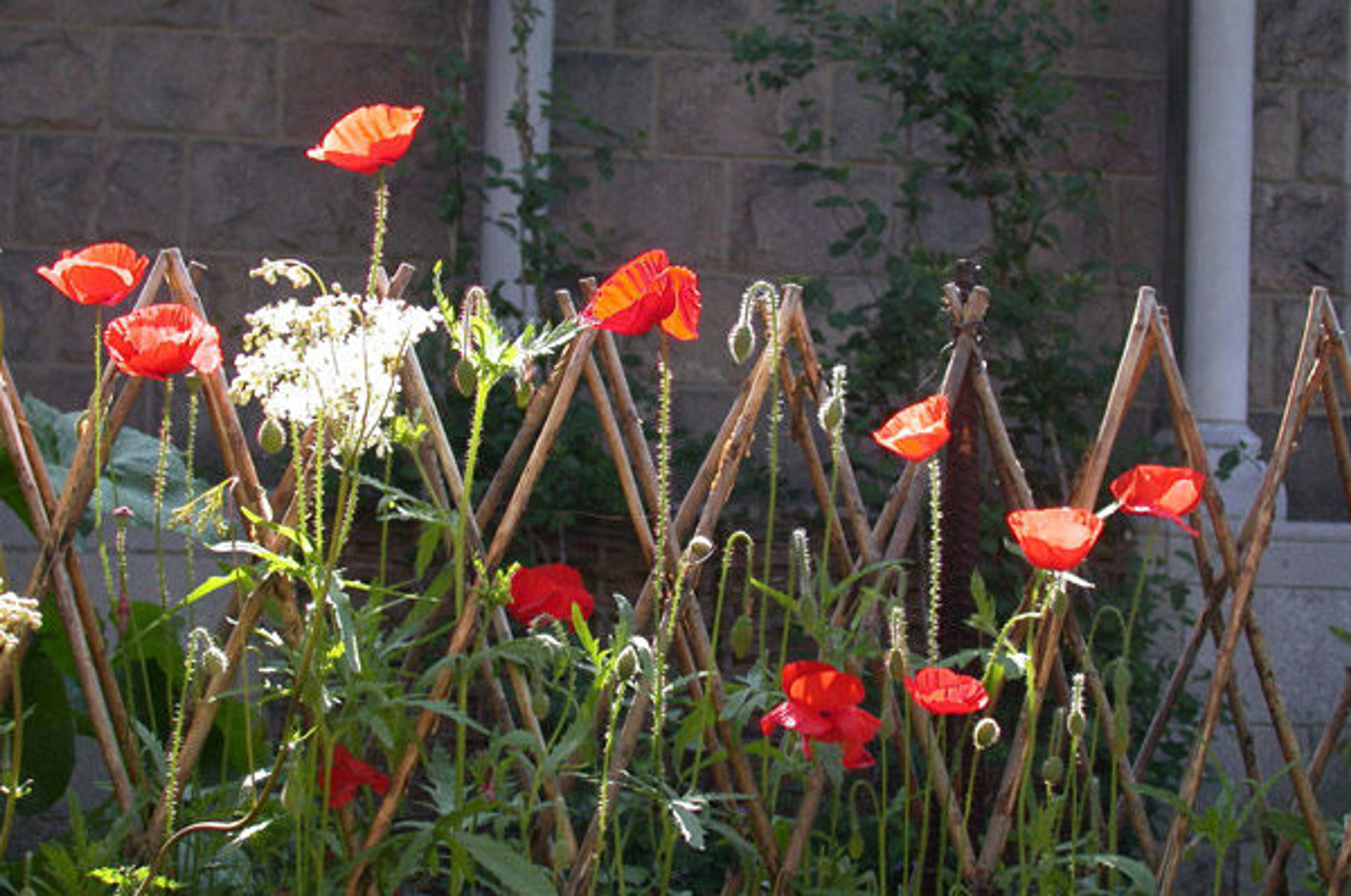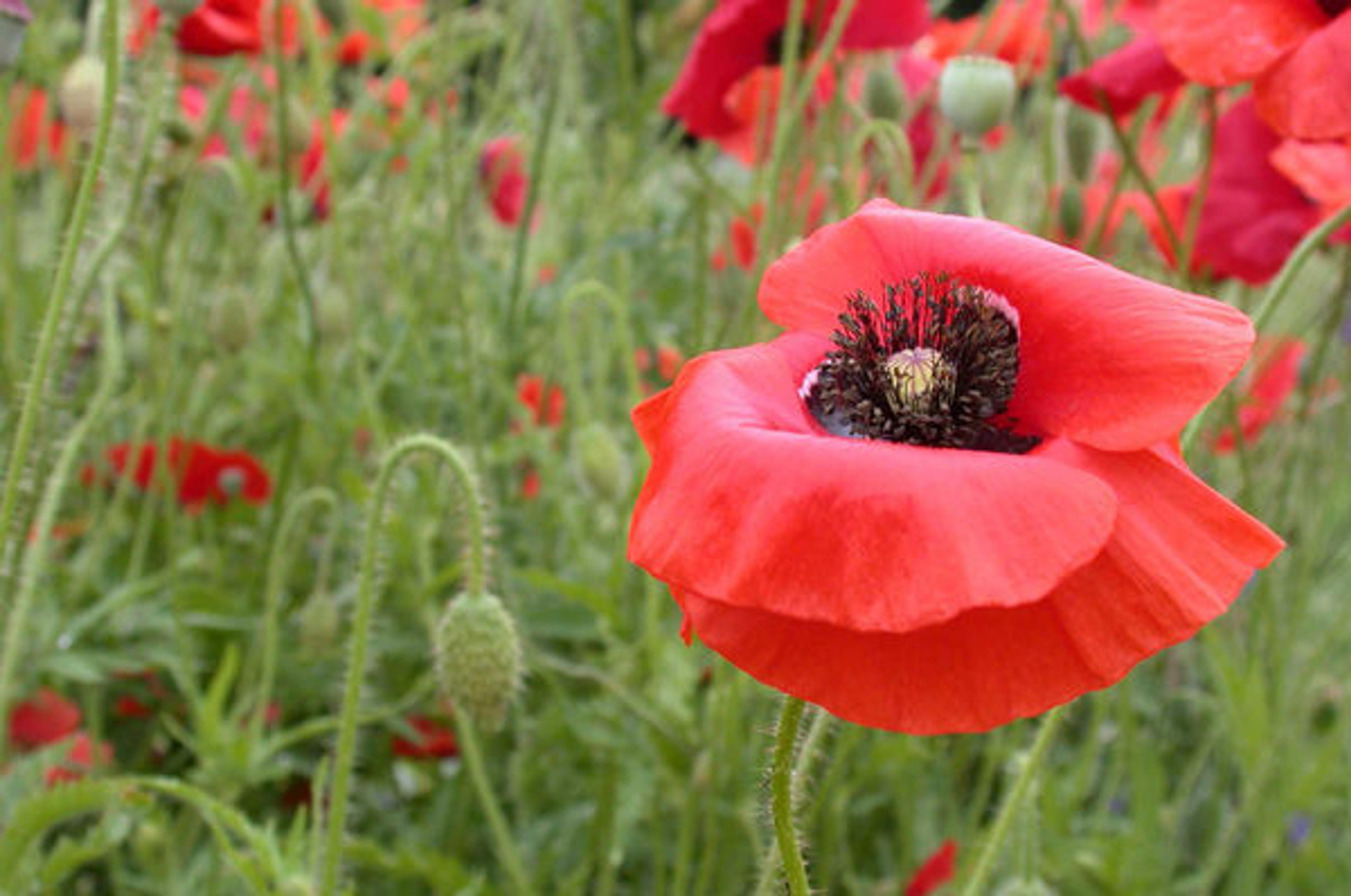
In the Bonnefont Herb Garden, we cultivate the corn poppy in a bed devoted to plants that were used for their presumed magical qualities. According to Geoffrey Grigson's An Englishman's Flora, "picking it brought thunder; but poppies placed among the timbers under the roof warded off lightning." All photographs from The Cloisters gardens' photo archives
«The corn poppy (Papaver rhoeas) is described as an annual weed that thrives on wastelands, roadsides, and neglected fields, and it is most famously associated with battlefields. As a denizen of disturbed lands, the poppy was one of the first and most striking colonizers of a trampled and scarred landscape. Its luminescent red flowers symbolize the blood of the fallen and serve as a reminder of the beauty of life amidst the devastation of war. Dubbed Flanders, or remembrance, poppy, the corn poppy is a symbol of the First World War in contemporary culture.»

With its showy and translucent crimson flowers, it is easy to see how the corn poppy is reminiscent of blood. The seeds of the corn poppy are quick to germinate and flower, and, as one of the first plants to flower, the petals of the corn poppy stood out in the stark, muddy, and scarred post battlefield landscape.
The association of poppies and the Great War is most often attributed to the poem "In Flanders Field" by John McCrae. Published one hundred years ago, the poem is thought to have been inspired by McCrae's reflections following the burial service of a young soldier and friend. In the poem, McCrae wrote of the casualties buried beneath the wind-blown poppies as being "between the crosses, row on row . . ."

However, the poppy's association with battles and bloodshed is even older. In Le Chanson de Roland, a medieval epic poem based on a battle during the reign of Charlemagne, the red of the poppy on the battlefield is likened to the "blood of all that chivalry" (Fisher, 100).
Left: The distinctive, crinkled red petals of the corn poppy ensconced in a bud
While the poppy is linked to some of history's darker periods, its appearance was celebrated in early agrarian societies. Considered a nuisance by modern farmers, the corn poppy was once viewed as a symbol of life and fertility. Before the widespread use of herbicides, the poppy grew in abundance among crops, and its vivid red flowers were indicative of earth's life-giving force. Far from a nuisance, the corn poppy was considered a companion to the crop. The Greeks dedicated the flower to Aphrodite, the goddess of vegetation, and depictions of the Roman corn goddess Ceres often show her grasping a sheaf of wheat interspersed with flowers and seed pods of the poppy (Grigson, 49).
Biblical exegesis also links the poppy to life and death, but with a slightly different interpretation. The corn poppy is thought by some scholars to be the biblical "flower of the fields." The ephemeral nature of the poppy's bloom, each lasting one day, is likened to the glory of man (Musselam, 133).
Like its close relative the opium poppy (Papaver somniferum), the seeds of the corn poppy were used as a food stuff, and the flowers and seedpods were used in medicine. A tea brewed from the petals of the corn poppy produced a traditional sedative. Dioscorides prescribed its use in the treatment of erysipelas, a bacterial infection of the skin sometimes called St. Anthony's fire. Medieval medicine classified the corn poppy's action as cold and dry—a useful antidote to the burning sensation of St. Anthony's fire (Bartsch, 225).
Sources
Anderson, Frank J., ed. "Herbals through 1500." In The Illustrated Bartsch 90. New York: Abaris, 1984.
Fisher, Celia. The Medieval Flower Book. London: The British Library, 2007.
Grigson, Geoffrey. The Englishman's Flora. 1955. Reprint: London: J. M. Dent & Sons, 1987.
Musselman, Lytton John. Figs, Dates, Laurel, and Myrrh. Portland, OR: Timber Press, 2007.